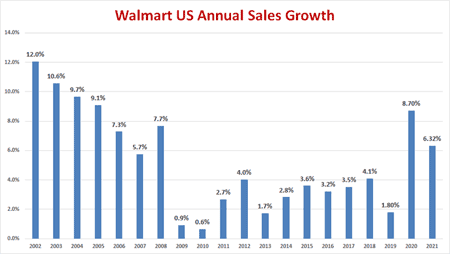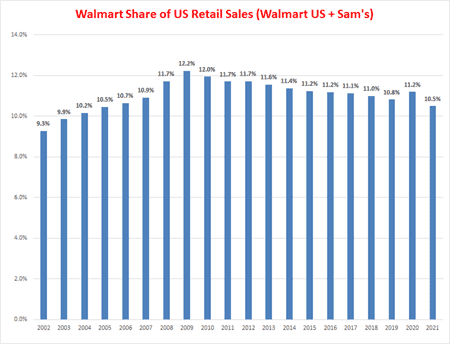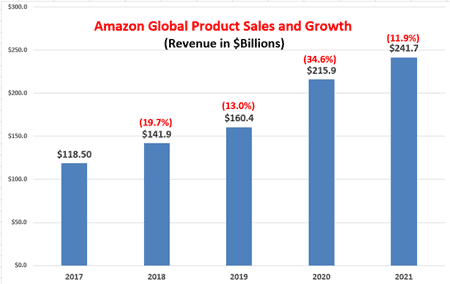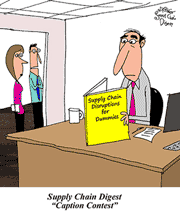Walmart and Amazon by the Numbers 2022
For many years now I have been doing an annual analysis and comparison of Walmart and Amazon, the two most important retailers in the world.
Walmart of course deserves that place due to its stature as still the world's largest merchant (and company) and one that represents an often substantial share of many consumer goods companies' total sales. But Amazon is closing in.
In terms of total revenue, Walmart came in at $572.8 billion for its fiscal year ending in January, a bit above the $559.2 in sales the previous year.
Amazon total revenue in 2021 was $469.8 billion, up substantially from the $386.0 billion in 2020. But we have to mark that with an asterisk, as I will explair later.
| GILMORE SAYS: |
WHAT DO YOU SAY?'
In fact, Amazon "product" sales in 2021 of $241.7 billion represented just 51% of total revenue, versus 49% for services.
Send us your
Feedback here
|
What Walmart and Amazon are doing is obviously of interest to most other retail and consumer goods manufacturers, and I hope others as well, as in the end almost every company is connected in the end to the retail supply chain.
You can make an argument I should throw China's Alibaba and maybe even JD.com into this mix as other ecommerce giants - one of these days. They both remain China/Asia centric - for now.
So let's start with Walmart, based again on its full fiscal year ending this past January.
While Walmart is an incredible giant, its growth had been slowing in recent years- until lately, during the pandemic. As can be seen in the chart below, Walmart's US sales (Walmart stores only) grew very rapidly in the beginning years of the 2000s, primarily by adding new superstores carrying groceries at a rapid pace into new markets.
But that growth soon decelerated, and in the recession year of 2009 started a pattern of mostly very low growth (2012 an exception) for a few years. As can be seen, growth since 2015 has been a solid 3-4% (solid for a company that size that isn't Amazon) until falling to 1.8% in 2019. It then jumped back up to a robust 8.7% growth in 2020 in the stay at home economy, but then also a strong 6.3% in 2021.
 ' '
See Full Size Image
Total Walmart US sales (Walmart US + Sam's Club) reached $466.9 billion last year, 151% growth versus the $188.8 billion those two segments had in 2002, but as noted above that pace of that growth has obviously slowed substantially down until the past two years. The Cumulative Average Growth Rate (CAGR) has averaged 4.8% since 2002, and now 4.9% since 2015 after two strong years.
Walmart's International's growth continues to struggle, despite an awful lot of attention and investment there for a time. Walmart International sales last year were $100.9 billion, down big from $121.3 billion the year before.
They were at $125 billion all the way back in 2011. International is clearly not the Walmart growth engine once imagined, and is now something of a boat anchor for financial performance.
Walmart still doesn't provide much detail on its ecommerce numbers, but it says it saw 11% growth in on-line sales in the US in calendar year 2021, versus 90% growth the year before. Rather amazingly, Amazon's on-line sales actually fell 1% in Q4 2021, and were down 3% in Q3. What is going on? Is it the market - or Amazon?
Still, in June Amazon had 39.5% of on-line market share in the US. compared with Walmart's 7%, according to estimates by research firm eMarketer.
Not all that many years ago, there were concerns (I think legitimately at the time) about Walmart gobbling a giant, monopolistic share of the US retail market. That fear has simply faded, in the face of declining or flat share and the rise of Amazon.
SCDigest developed a methodology several years ago, where we compare Walmart's total US store sales versus relevant US retail figures - total retail minus autos and parts, gas station and other fuel sales, and restaurants/bars.
It's not quite perfect because Walmart does sell some gasoline, but it doesn't break it out in a way we can use. Nevertheless, I think what we have is pretty good - and does reflect a higher share of US retail sales for Walmart than if you do not exclude those categories, which is how it often reported. When you hear numbers like this, make sure you understand how they are calculated.
By our measure, as seen in the chart below, Walmart had an 10.5% of US retail sales in 2021, down from a peak of 12.2% in 2009.
As an aside, Amazon does not break out its sales in a way that would allow me to do the same analysis on Amazon's share of total US retail sales.

See Full Size Image
No one is worried any more that Walmart will take over the retail industry. Amazon is now in the regulatory crosshairs.
The big question: will Amazon overtake Walmart for the top US retail spot soon?
Another question: Would the FTC now let Walmart (or Amazon) buy say Kroger or CVS? Hard to say. I think a definite No for Amazon.
Turning to Amazon, it provides a lot of numbers to analysts but getting the best insight from them takes some work. That is because of its several business units and how it computes certain ratios, and (unfortunate) changes it has made in the past few years in what numbers it provides.
Again, total sales in 2021 were $469.8 billion, up from $386.0 billion the previous year, rising 21.7%. However, that includes Whole Food stores, digital media sales, subcriptions, its fast growing web services unit and advertising revenue. It also includes revenue from commissions from sellers on its marketplace sites, and logistics services, none of which is broken out in detail.
In fact, "product" sales in 2021 of $241.7 billion represented just 51% of total revenue, versus 49% for services.
The chart below shows Amazon's recent growth product sales - but this is on a global basis, not US only. Amazon once broke out product sales in more detail by business segment, but it no longer does.

'
See Full Size Image
As briefly noted above, it used to be easier to track Amazon's logistics costs, which include fulfillment (distribution center costs, including amortization of all those expensive FCs, plus some inbound transportation costs), and shipping expense, which is accounted for separately from fulfillment.
Amazon used to report net shipping expense (shipping costs minus any shipping revenues, including an allocation of Prime subscription sales), but it no longer does. That said, I am sure shipping still is a big loss leader for Amazon, almost surely several billion dollars per year at minimum.
But as a quick calculation, Amazon spent $75.1 billion globally on fulfillment in 2021 , and $76.5 billion on shipping, for a total logistics spend of an incredible $151.6 billion. That was up 27% over 2020 - versus growth in product sales of 11.9%. By my way of thinking, that means logistics costs as a percent of phyical product sales are continuing to rise rapidly at Amazon.
I am out of room, even though I have more. Will do a part 2 on this as I did last year in a week or two.
Any reaction to these numbers from Amazon and Walmart? Any other data you would like to see? Let us know your thoughts at the Feedback button or section below. |






 '
'




